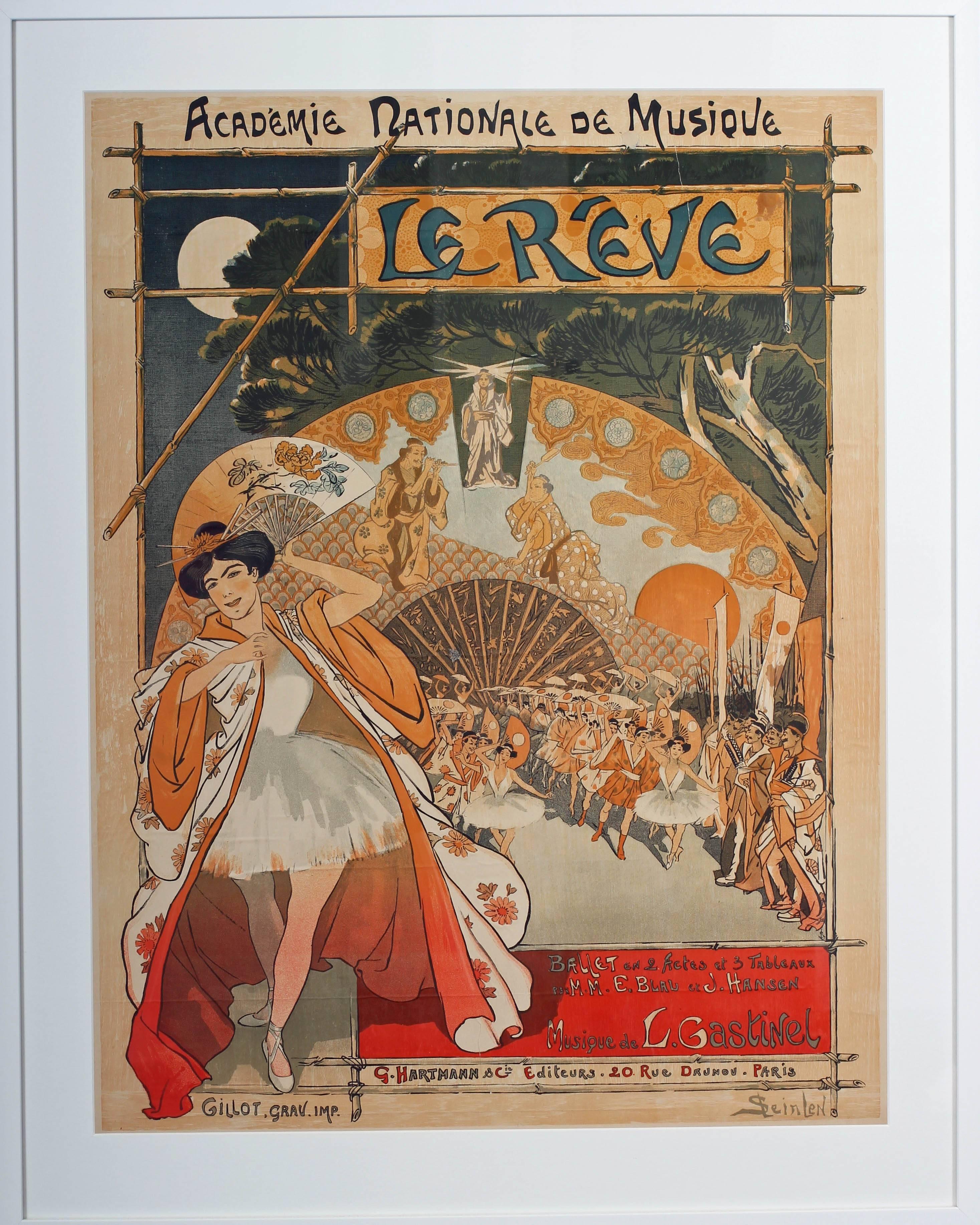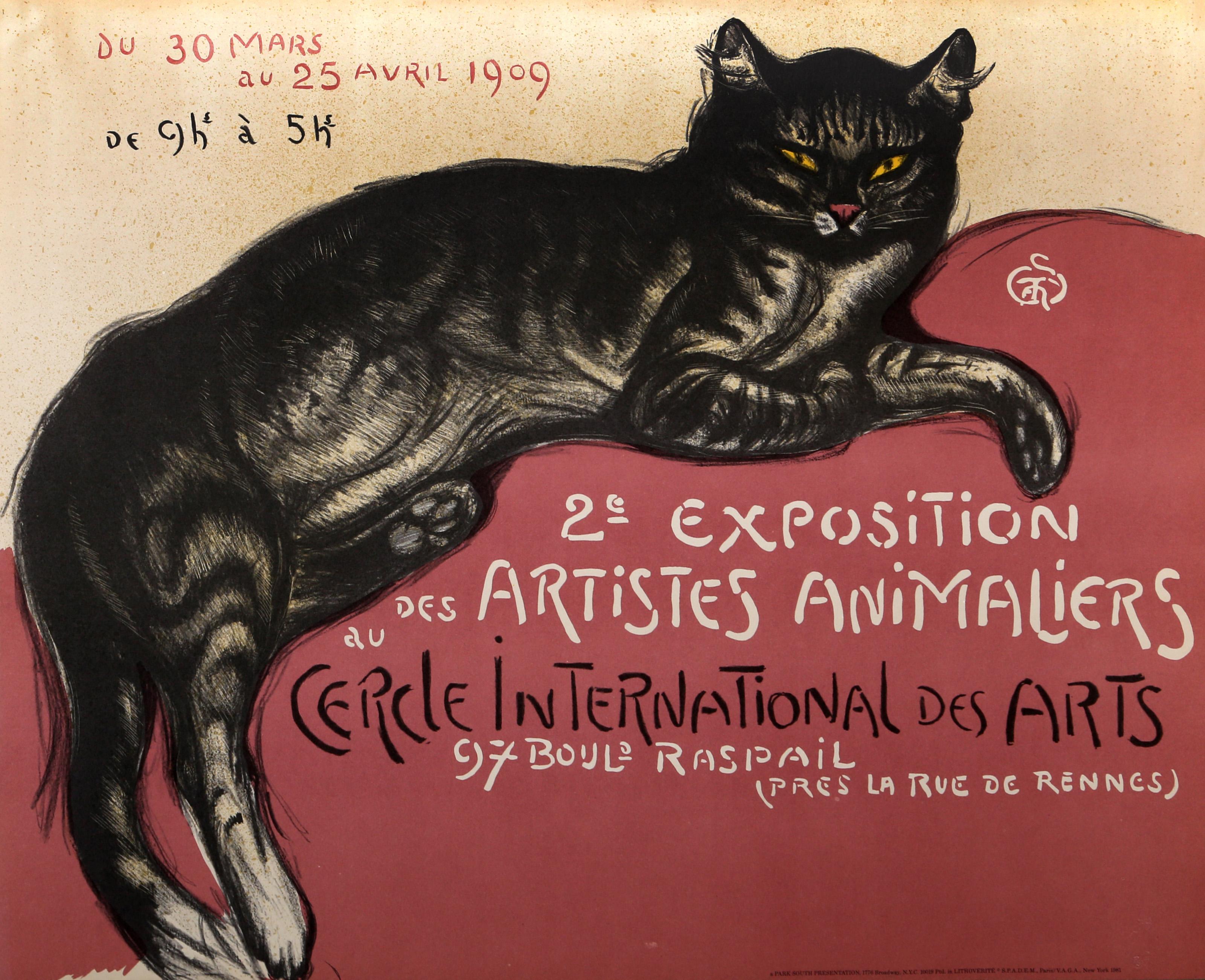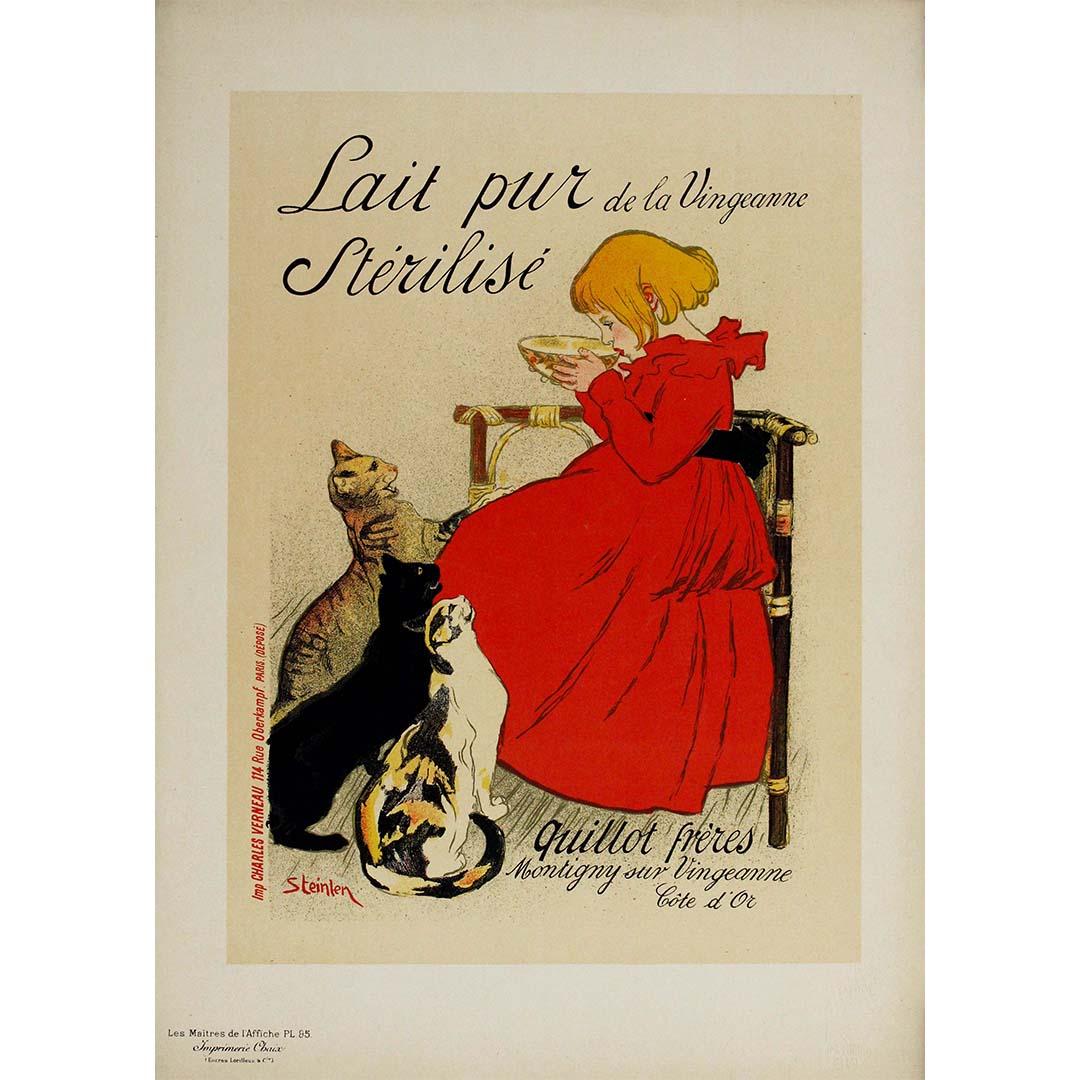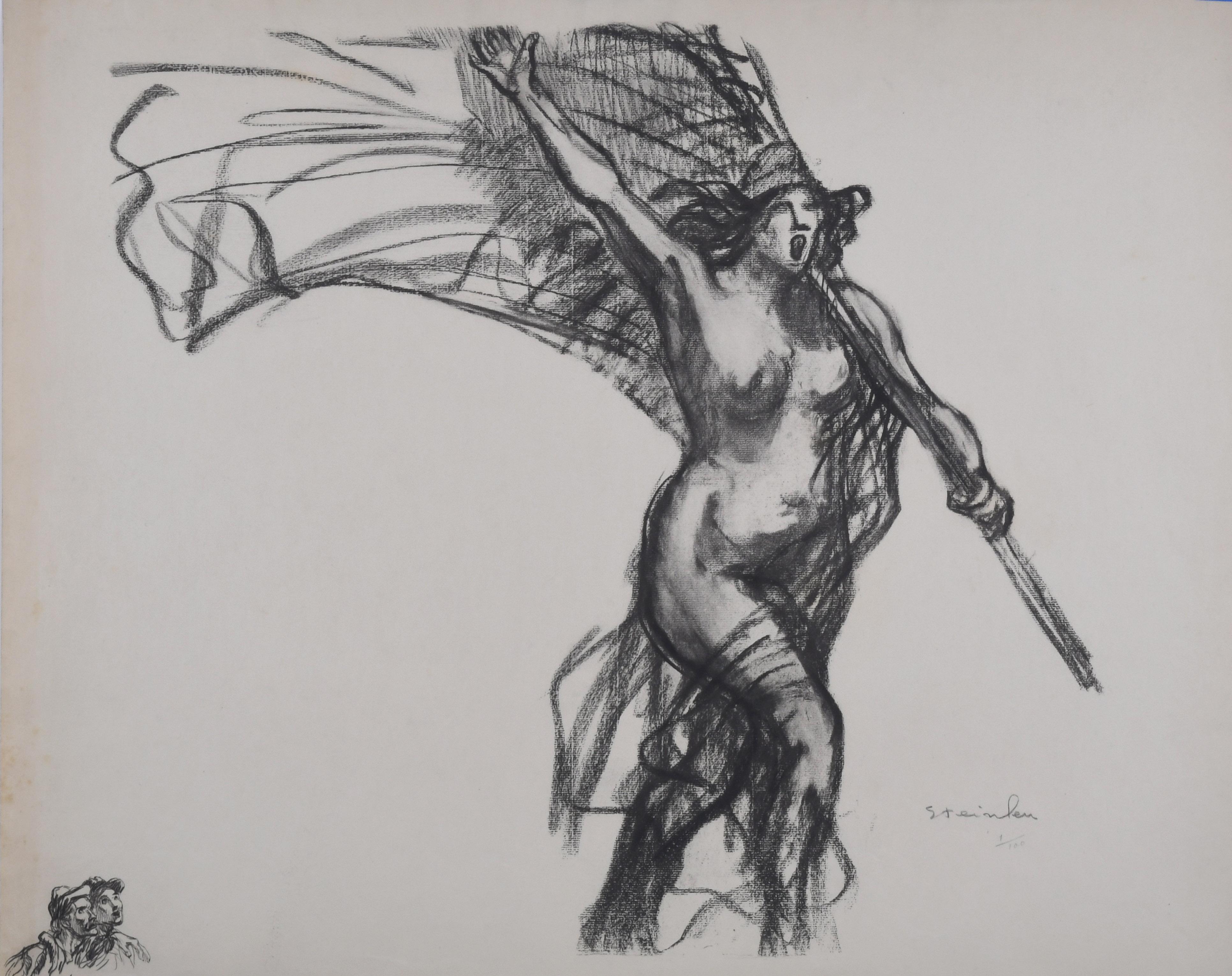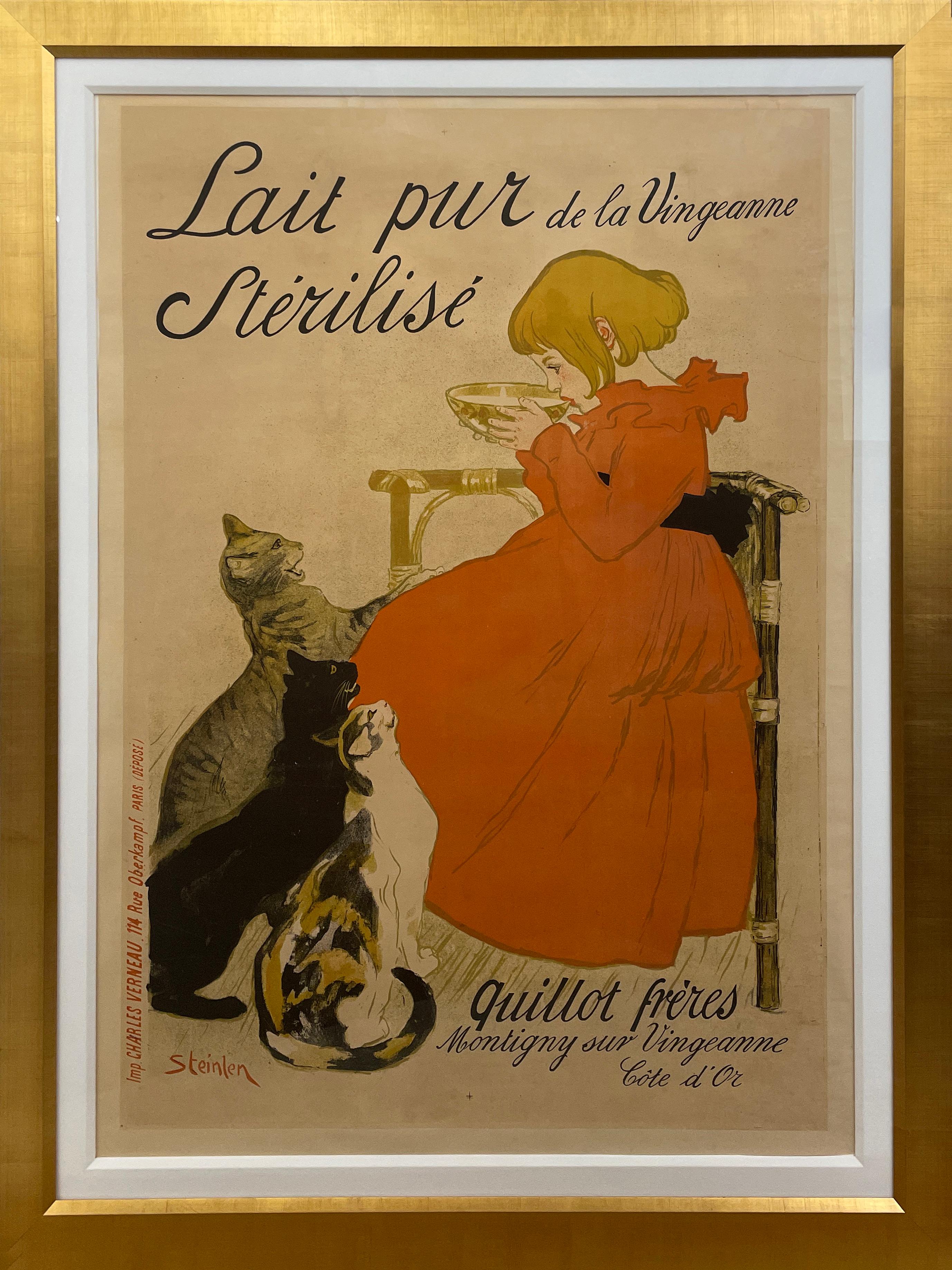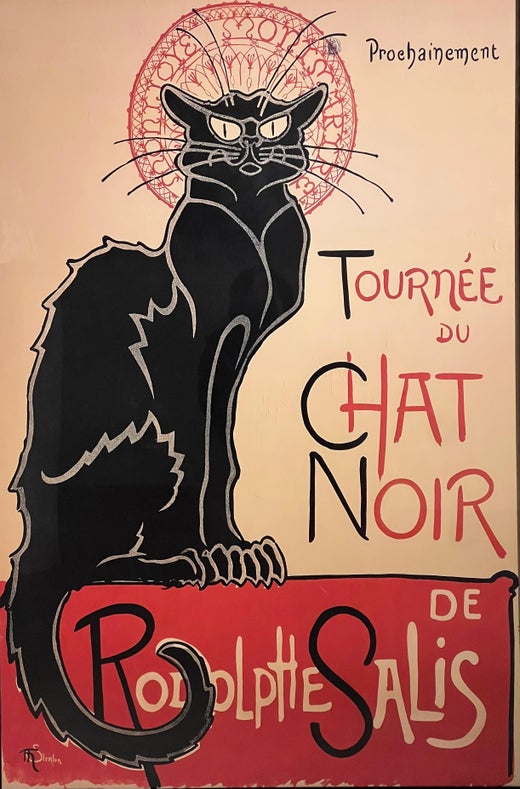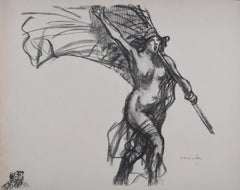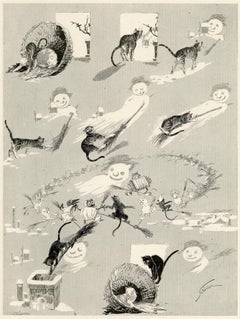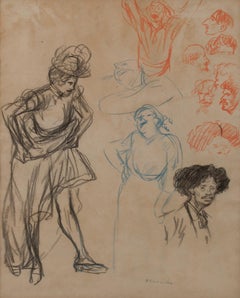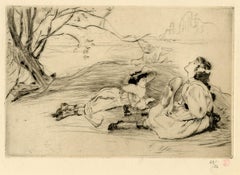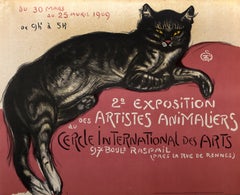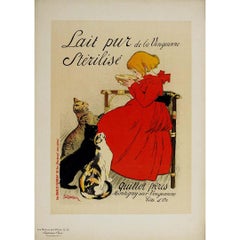Items Similar to Le Rêve (The Dream)
Want more images or videos?
Request additional images or videos from the seller
1 of 11
Théophile Alexandre SteinlenLe Rêve (The Dream)1890
1890
$1,200
£928.15
€1,056.65
CA$1,723.01
A$1,882.44
CHF 986.59
MX$22,476.90
NOK 12,485.41
SEK 11,642.39
DKK 7,891.46
About the Item
Le Rêve (The Dream)
Color gillotage poster, 1890
Signed in the image lower right corner (see photo)
This poster for a ballet at the Académie nationale de musique in Paris is typical of the craze for all things Japanese in the last quarter of the nineteenth century. Japan became fashionable following the re-establishment of commercial links in the Meiji era: Japan began to take part in universal exhibitions, playing into colonial-era France’s enthusiasm for exotica. The arts eagerly packaged Japanese culture for Western audiences, as demonstrated by this poster for a ballet by Léon Gastinel, featuring marches for the goddess Benten and Mikagura waltzes.
Théophile-Alexandre Steinlen’s design includes all the popular clichés – a bamboo frame around the title, Japanese-style lettering, a fan decorated with figures from traditional mangas, a moonlit landscape, and a white pine tree. The main figure wears a tutu and ballet tights and shoes beneath her kimono. Half geisha, half ballerina, she steps towards the audience: she is both an untouchable idol and a woman ready to trade her affections, inviting her wealthy male admirers to join her in her dressing room.
This was one of Steinlen’s earliest poster designs. He worked with a reed pen, brush, and scraper, borrowing the large swathes of colour from Japanese prints. The impression of transparency is created by overlaying a matrix for each of five colours – pale and dark ochre, vermilion, grey, and grey-blue. It was quite a technical feat for its day, using a new photomechanical relief printing process known as gillotage after its inventor, the printer Charles Gillot. His name also features on the poster: perhaps not coincidentally, he was one of the leading collectors of Japanese art of his day.
This poster was made for the Academie Nationale de Musique. The image "shows the giant fan that is opened in Act I that is opened by a magical arrow shot. At the top is the golden goddess Isanami, who leads the heroine behind the fan into a dream experience" (French Opera, p. 28)
Publisher: Gillot, Paris
Condition: Excellent
Poster size: 34 x 25 inches
Reference:
Guy Ducrey, Tout pour les yeux. Littérature et spectacle autour de 1900, Paris, PUPS, 2010.
Philippe Kaenel, in collaboration with Catherine Lepdor, Théophile-Alexandre Steinlen. L’œil de la rue, exh. cat. Lausanne, Musée cantonal des Beaux-Arts, Milan, 5 Continents Editions, 2008: n. 61.
Réjane Bargiel and Christophe Zagrodzki, Steinlen affichiste. Catalogue raisonné, Lausanne, Editions du Grand-Pont, 1986: n. 10.
- Creator:Théophile Alexandre Steinlen (1859 - 1923, French)
- Creation Year:1890
- Dimensions:Height: 34 in (86.36 cm)Width: 25 in (63.5 cm)
- Medium:
- Movement & Style:
- Period:
- Condition:
- Gallery Location:Fairlawn, OH
- Reference Number:Seller: FA87751stDibs: LU14014663702
Théophile Alexandre Steinlen
Theophile Alexandre Steinlen was born in Lausanne in 1859. He was naturalized French in 1901. He was a painter, engraver, illustrator, poster artist and sculptor. Before settling in Paris, he made a detour to Mulhouse where one of his uncles placed him in the studio of one of the best lithographers of the time. He settled definitively in Montmartre in 1881. Willette introduced him to his companions of the Cabaret du Chat-Noir animated by Rodolphe Salis. He met Toulouse-Lautrec, Forain, Léandre, Debussy, Eric Satie, Verlaine, Alphonse Allais and Aristide Bruant. He took part in the performances of the famous cabaret's shadow theater with animal stories and, most often, sequences featuring cats, for which he has a particular affection. The felines will appear throughout his activity as "parentheses" in a tormented work. There is, in this torment, the expression of no personal problem but a painful compassion for the lives of the exploited and marginal beings. He painted and drew idylls, balls and bastrings, workers, kids and gosselin, the poor, the little workers, girls and marlous. He sometimes made posters. In the most successful of them (« Le lait pur de la Vingeanne » et le « Fer Bravais ») he imposed, relevant or not, the presence of cats.
In 1901, Steinlen worked for L'Assiette au beurre , the most virulent satirical newspaper ever published and takes readily to target the institutions of the 3rd Republic.
His works are found in numerous Public Collections, such as Petit Palais in Geneva, Hermitage Museum in Saint Petersburg, and the National Gallery of Art in Washington.
About the Seller
5.0
Recognized Seller
These prestigious sellers are industry leaders and represent the highest echelon for item quality and design.
Gold Seller
Premium sellers maintaining a 4.3+ rating and 24-hour response times
Established in 1978
1stDibs seller since 2013
827 sales on 1stDibs
Typical response time: <1 hour
Associations
International Fine Print Dealers Association
- ShippingRetrieving quote...Shipping from: Akron, OH
- Return Policy
More From This Seller
View All“La Rèpublique nous appelle…” (The Republic calls us…)
By Théophile Alexandre Steinlen
Located in Fairlawn, OH
La République Nous Appelle (The Republic Calls Us)
Transfer lithograph with an etching Remarque in the lower left corner, 1915
Signed in pencil lower right (see photo)
Edition: 100 (...
Category
1910s Figurative Prints
Materials
Lithograph
"Kitten Went in the Night" (A black cat playing with broom and Halloween ghost)
By Théophile Alexandre Steinlen
Located in Fairlawn, OH
"Kitten Went in the Night" (A black cat playing with broom and Halloween ghost) from Le Chat Noir
Gillotage chromotype, 1898
Signed in the image lower right
Cats were a symbol of fr...
Category
1890s Impressionist Animal Prints
Materials
Other Medium
Double sided crayon drawing in colors: Study for "The Shoe" (recto)
By Théophile Alexandre Steinlen
Located in Fairlawn, OH
Double sided crayon drawing:
Front: Study for "The Shoe"
Reverse: Studies of Figures
Blue crayon, red and black crayons
Image size: 19.25 x 15.375 inches
Frame size: 30 x 25 1/2 inch...
Category
1890s Art Nouveau Figurative Drawings and Watercolors
Materials
Crayon
A L'Ombre (In Shadow)
By Louis Legrand
Located in Fairlawn, OH
A L'Ombre (In Shadow)
Etching & drypoint, 1905
Signed with the red stamp of the publisher Pellet (see photo)
Edition: 50 on velin paper, signed and numbered
Publisher: Gustav Pellet, Paris (his red stamp lower right, recto; Lugt 1193)
Condition: Excellent
Image/Plate size: 5-7/8 x 8-5/8" (14.8 x 21.8 cm.)
Sheet size: 11 5/8 x 17 1/8"
Reference: IFF 119
Exteens 229
Arwas 256 v/V
Louis Auguste Mathieu Legrand (29 September 1863 – 1951) was a French artist, known especially for his aquatint engravings, which were sometimes erotic. He was awarded the Légion d'honneur for his work in 1906.
Life
Legrand was born in the city of Dijon in the east of France. He worked as a bank clerk before deciding to study art part-time at Dijon's Ecole des Beaux-Arts. He won the Devosge prize at the school in 1883.[2] In 1884 Legrand studied engraving under the Belgian printmaker Félicien Rops.
Legrand's artworks include etchings, graphic art and paintings. His paintings featured Parisian social life. Many were of prostitutes, dancers and bar scenes, which featured a sense of eroticism. According to the Hope Gallery, "Louis Legrand is simply one of France's finest early twentieth century masters of etching." His black and white etchings especially provide a sense of decadence; they have been compared to those of Henri de Toulouse-Lautrec, though his drawings of the Moulin Rouge, the can-can dance and the young women of Montmartre preceded Toulouse-Lautrec's paintings of similar scenes. He made over three hundred prints of the night life of Paris. They demonstrate "his remarkable powers of observation and are executed with great skill, delicacy, and an ironic sense of humor that pervades them all."
Two of his satirical artworks caused him to be tried for obscenity. The first, "Prostitution" was a symbolic drawing which depicted a naked girl being grasped by a dark monster which had the face of an old woman and claws on its hands; the second, "Naturalism", showed the French novelist Émile Zola minutely studying the thighs of a woman with a magnifying glass. Defended by his friend the lawyer Eugène Rodrigues-Henriques (1853–1928), he was found not guilty in the lower court, but was convicted in the appeal court and then given a short prison sentence for refusing to pay his fine.
Legrand was made famous by his colour illustrations for Gil Blas magazine's coverage of the can-can, with text by Rodrigues (who wrote under the pseudonym Erastene Ramiro). It was a tremendous success, with the exceptional quantity of 60,000 copies of the magazine being printed and instantly sold out in 1891.
In 1892, at the instigation of the publishing house Dentu, Legrand made a set of etchings of his Gil Blas illustrations. The etchings were published in a book, Le Cours de Danse Fin de Siecle (The End of the Century Dance Classes).
Legrand took a holiday in Brittany, which inspired him to engrave a set of fourteen lithographs of simple country life called Au Cap de la Chevre (On Goat Promontory). It was published by Gustave Pellet who became a close friend of Legrand's. Pellet eventually published a total of 300 etchings by Legrand, who was his first artist; he also published Toulouse-Lautrec and Félicien Rops among others.
He did not only work in graphics; he exhibited paintings at the Paris salon of the Société Nationale des Beaux-Arts starting in 1902. In 1906 he was made a chevalier of the Légion d'honneur.
Legrand died in obscurity in 1951. A retrospective exhibition was held at the Félicien Rops museum in Namur, Belgium in 2006 to celebrate his graphic art. The art collector Victor Arwas published a catalogue raisonné for the occasion.
Books illustrated
de Maupassant, Guy: Cinq Contes Parisiens, 1905.
Poe, Edgar Alan: Quinze Histoires d'Edgar Poe...
Category
Early 1900s Art Nouveau Landscape Prints
Materials
Etching
Programme poour Le Chariot de Terre Cutte
By Henri de Toulouse-Lautrec
Located in Fairlawn, OH
Programme poour Le Chariot de Terre Cutte
Lithograph printed in blue on pink tint thin wove paper, 1895
Signed with the artist's "TL" monogram (see photo) lower center edge
Published...
Category
1890s Art Nouveau Portrait Prints
Materials
Lithograph
A black and white cat play with a mouse, from Le Chat Noir
By Théophile Alexandre Steinlen
Located in Fairlawn, OH
A black and white cat play with a mouse, from Le Chat Noir
Gillotage chromotype, 1898
Signed in the image lower right (see photo)
An impression of this image is in the collection of ...
Category
1890s Impressionist Animal Prints
Materials
Other Medium
You May Also Like
Original French early 20th Century Theatre poster of 'Le Reve'
By Théophile Alexandre Steinlen
Located in Petworth, West Sussex
Le Reve (The dream)
An original theatre poster designed by Theophile Alexandre Steinlen for Le Reve at the Academie Nationale de Musique
96 x 76cm. (incl. frame)
New white wood fram...
Category
Early 20th Century Art Nouveau Figurative Prints
Materials
Lithograph
Impressionist Scenes - Lithograph (Les Maîtres de l'Affiche), 1895
By Théophile Alexandre Steinlen
Located in Paris, IDF
Théophile Alexandre STEINLEN
Impressionist Scenes (Mothu et Doria), 1895
Stone lithograph
Printed signature in the plate
On vellum
Size 39 x 29 cm (c. 15.3 x 11.4")
INFORMATION : Plate 46 of "Les Maîtres...
Category
1890s Art Nouveau Figurative Prints
Materials
Lithograph
Artiste Animaliers, Art Nouveau Poster by Theophile Alexandre Steinlen
By Théophile Alexandre Steinlen
Located in Long Island City, NY
Theophile Alexandre Steinlen, French/Swiss (1859 - 1923) - Artiste Animaliers, Year: 1981, Medium: Poster with Embossed Cat Blindstamp, Size: 20.5 x 25 in. (52.07 x 63.5 cm), Prin...
Category
1980s Art Nouveau Animal Prints
Materials
Offset
1897 Original Poster - Les Maîtres de l'affiche Pl. 95 Lait pur de la Vingeanne
By Théophile Alexandre Steinlen
Located in PARIS, FR
Théophile-Alexandre Steinlen's "Lait pur de la Vingeanne stérilisé" poster, created in 1897 for Les Maîtres de l'Affiche in plate number 95, is an outstanding...
Category
1890s Art Nouveau Prints and Multiples
Materials
Paper, Lithograph
"Lait Pur Sterilise de la Vingeanne" Antique Poster by Steinlen
By Théophile Alexandre Steinlen
Located in Hinsdale, IL
Steinlen, Theophile
"Lait Pur Sterilise de la Vingeanne"
Original lithograph, c. 1894
Rennert 12
Printed by Charles Verneau, Paris
Bright Fresh Colors, RARE...
Category
1890s Art Nouveau Figurative Prints
Materials
Lithograph
Femme de Chagrin
By Théophile Alexandre Steinlen
Located in New York, NY
Theophile Alexandre Steinlen (1859-1923), Femme de Chagrin, 1894, lithograph, signed in pencil lower right [also signed in the plate lower center]. Reference: Crauzat 454, first stat...
Category
1890s Post-Impressionist Figurative Prints
Materials
Color Pencil, Lithograph
More Ways To Browse
Antique Geisha
Antique Idols
Antique Japanese Fans
Antique Scraper
Large Japanese Print
G Rouault
Gay Vintage Posters
Georges Rouault Christ
Georges Rouault Fleurs
Giovanni Domenico Campiglia
Gitanes Poster
Gold Lips Art
Hamed Abdalla
Henri Matisse Print Signed
Henry Cliff
Henry Moore Lithograph Signed
Hirst Minnie
Hokusai Original Print
